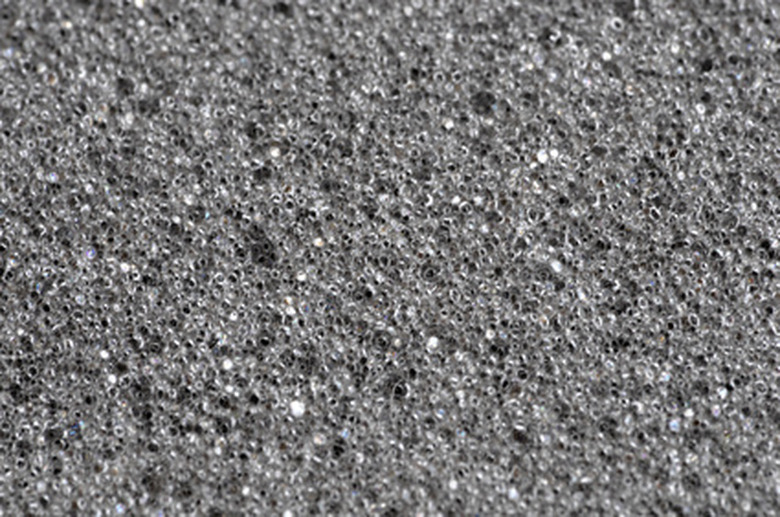What Minerals Make Up Pumice?
Pumice is an extrusive volcanic rock that spews from erupting volcanoes as magma forms foam when combining with various volatile gasses and water at the surface, trapping air bubbles inside the rock as it rapidly cools, according to the Mineral Information Institute. The pumice stone is extremely rough and very porous and surprisingly light when picked up. This is the only stone that will actually float on water until becoming waterlogged, at which point it will sink. The mineral makeup of pumice depends on the type of magma that composes the pumice foam.
Basalt Minerals
Basalt Minerals
Basalt is a gray to black fine-grained volcanic rock that is often the origin of pumice. This type of rock is rich in iron and magnesium and often contains the minerals olivine, pyroxene and plagioclase, according to the U.S. Geological Survey Cascades Observatory website.
Basalt erupts at temperatures up to 1,250 degrees Celsius and forms the pumice stones often found in Washington, Oregon and Idaho. Basalt is the most abundant rock on earth, making up the majority of the bottom of the sea.
Andesite Minerals
Andesite Minerals
Andesite is another extrusive volcanic rock that is usually light gray and sometimes has red or green color. This fine-grained rock comes primarily from stratovolcanoes such as Mount Fuji in Japan. These are tall, cone-shaped volcanoes also referred to as composite volcanoes. Andesite erupts around 900 to 1,100 degrees Celsius, according to the U.S. Geological Survey Cascades Volcano Observatory website. The lava flows are often very long and thick. The rock is found commonly in the Andes Mountains in South America.
The composition of andesite includes large amounts of silica and plagioclase feldspar as well as various levels of pyroxene, horneblende and olivine. Andesite may also contain bubbles and quartz.
Dacite Minerals
Dacite Minerals
Dacite is an extrusive volcanic rock made up of two-thirds silica. The rock is light gray in most instances and is named for the Roman province called Dacia, where most of this type of rock comes from near the Danube Rive, according to the U.S. Geological Survey Cascades Volcano Observatory website.
Dacite and the pumice stones it produces are composed of plagioclase feldspar, quartz, biotite and hornblende, according to the Encyclopedia Britannica website. It erupts between 800 and 1,000 degrees Celsius and is most commonly associated with the devastating eruptions known as Plinians, the type of eruption that occurred at Mount Vesuvius in 79 AD and Krakatoa in 1883.
Rhyolite Minerals
Rhyolite Minerals
Rhyolite is an extrusive volcanic rock that cools quickly and forms tiny crystals, giving it a glass-like appearance. It is similar to granite and contains the minerals quartz, feldspar and biotite. The rock is typically light gray to pink or red and has very fine grains.
Rhyolitic eruptions are high in viscosity and happen between 700 and 850 degrees Celsius. When gas is present with these eruptions, they can be very violent and throw pumice stones high into the air. One of the largest rhyolitic eruptions happened in New Zealand at Lake Taupo more than 26,000 years ago, according to the GNS Science website on New Zealand's volcanoes.
Cite This Article
MLA
Morgan, Lee. "What Minerals Make Up Pumice?" sciencing.com, https://www.sciencing.com/minerals-make-up-pumice-6825719/. 24 April 2017.
APA
Morgan, Lee. (2017, April 24). What Minerals Make Up Pumice?. sciencing.com. Retrieved from https://www.sciencing.com/minerals-make-up-pumice-6825719/
Chicago
Morgan, Lee. What Minerals Make Up Pumice? last modified August 30, 2022. https://www.sciencing.com/minerals-make-up-pumice-6825719/
